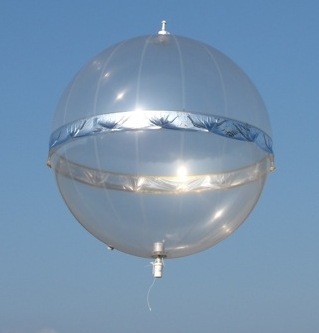Purpose of the flight and payload description
Boundary Layer Pressurized Balloons are small balloons that keep a constant volume and thus fly at a nearly constant density level, acting as Lagrangian tracers of air particles and meteorological platforms. Their envelopes are manufactured by ZODIAC Int. under CNES supervision; with a 2.5 m diameter, they are made of three-laminated polyethylene of 120 microns thickness. Balloons are inflated with Helium at a nominal surpressure of 120 hPa at flight level. Total mass is around 9 Kg.
The BLPB can fly between the surface and 830 hPa, depending of its ballast. As long as the surpressure is maintained the volume remains constant; except for small thermal fluctuations, mainly due the diurnal cycle, inducing small altitude oscillations. Historically, the most serious problem encountered by these balloons is due to the water loading under heavy rain or when the envelope temperature is below the dew point temperature, specially by radiative cooling during night. To prevent this the BLPB envelope is treated with a hydrophobic coating. Also the metallic band attached to the equator of some of the balloons serve to difficult more the adherence of water in case the balloon land in the ocean due to rain.
Scientific instrumentation onboard includes pressure, humidity and temperature sensors and a 3D GPS from witch the balloon velocity can be deduced. This gondola is located in the top of the balloon. Helium pressure and temperature are also monitored. Meteorological data are recorded on board every 10 seconds then averaged on a time interval between 10 seconds and a few minutes. Aditional instrumentation carried by the balloons for this specific campaign were an ozone sensor, a flow meter and aerosol counter. Data are transmitted periodically (at flight level every 20 minutes) by means of the Iridium communication system located in the control gondola attached to the lower pole of the balloon. The balloon flight can be stopped either automatically if the balloon approaches a specific zone or by a remote command. Both gondolas are connected each other by a radio link to avoid wiring the balloon envelope.
This balloon flight was part of a campaign denominated ChArMEx (Chemistry-Aerosol Mediterranean Experiment), aimed to perform a scientific assessment of the present and future state of the atmospheric environment and of its impacts in the Mediterranean basin. During this second part of the campaign that endured between July and August 2013 were launched 12 balloons from Ile du Levant a small French island located in the Gulf of Lion off the coast of the Riviera, near Toulon.
Details of the balloon flight
Balloon launched on: 7/29/2013 at 21:55 utc
Launch site: Ile du Levant, France
Balloon launched by: Centre National d'Etudes Spatiales (CNES)
Balloon manufacturer/size/composition: Super Pressure Balloon
Flight identification number: B61
End of flight (L for landing time, W for last contact, otherwise termination time): 7/30/2013 at 13:25 utc
Balloon flight duration (F: time at float only, otherwise total flight time in d:days / h:hours or m:minutes - ): 15 h 30 m
Landing site: In the Thyrrenian Sea between Corsica and Italy
External references
- BAMED - Balloons over the Mediterranean sea website Laboratoire de Météorologie Dynamique (LMD)
12221If you consider this website interesting or useful, you can help me to keep it up and running with a small donation to cover the operational costs. Just the equivalent of the price of a cup of coffee helps a lot.


